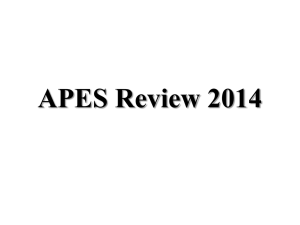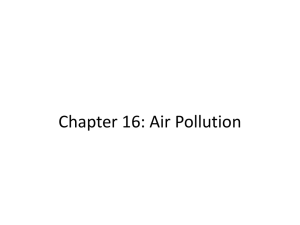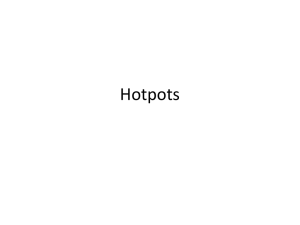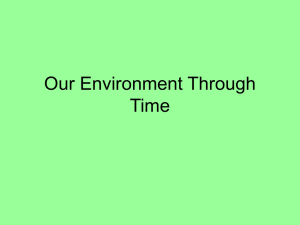measurement of pollutants in water
advertisement
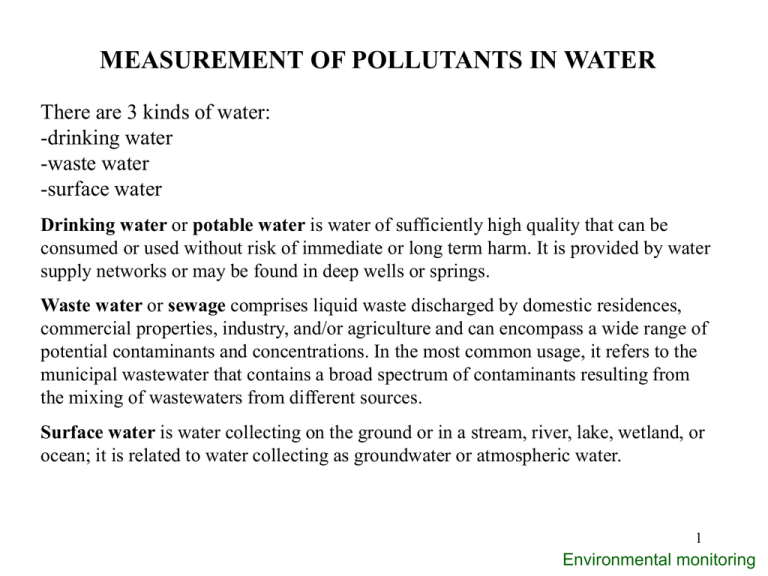
MEASUREMENT OF POLLUTANTS IN WATER There are 3 kinds of water: -drinking water -waste water -surface water Drinking water or potable water is water of sufficiently high quality that can be consumed or used without risk of immediate or long term harm. It is provided by water supply networks or may be found in deep wells or springs. Waste water or sewage comprises liquid waste discharged by domestic residences, commercial properties, industry, and/or agriculture and can encompass a wide range of potential contaminants and concentrations. In the most common usage, it refers to the municipal wastewater that contains a broad spectrum of contaminants resulting from the mixing of wastewaters from different sources. Surface water is water collecting on the ground or in a stream, river, lake, wetland, or ocean; it is related to water collecting as groundwater or atmospheric water. 1 Environmental monitoring Environment Monitor Water Quality (video clip) 2 Environmental monitoring MEASUREMENT OF POLLUTANTS IN WATER Regulations Environmental Protection Law 137/1995 updated by Ordonance 195/2005 Waste water Law: HG 352/2005, completion of HG 188/2002 refers to 2 types of waste water: - industrial and urban waste waters overflowed into natural receivers (lakes, rivers) (NTPA 001) - waste waters overflowed into sewerage networks (NTPA 002) 3 Environmental monitoring MEASUREMENT OF POLLUTANTS IN WATER Waste water quality standard NTPA 001 (several chemical indicators) No. Quality indicator Unit Limit values Analysis method 1. pH pH units 6,5-8,5 SR ISO 10523-97 2. Suspended materials mg/dm3 35,0 (60,0) STAS 6953-81 3. Biochemical Oxygen Demand at 5 days mg O2/dm3 25,0 SR EN 1899-2/2002 4. Chemical Oxygen Demand (CCOCr) mg O2/dm3 125,0 SR ISO 6060-96 5. Ammonia (NH4+)6) mg/dm3 2,0(3,0) SR ISO 5664:2001 SR ISO 7150-1/2001 6. Nitrates (NO3-)6) mg/dm3 25,0(37,0) SR ISO 7890-2:2000; SR ISO 7890-3:2000 7. Sulphide (S2-) mg/dm3 0,5 8. Phenols (C6H5OH) mg/dm3 0,3 9. Oil products mg/dm3 5,0 SR 7877/1-95 10. Total phosphorus (P)6) mg/dm3 1,0(2,0) SR EN 1189-2000 11. Synthetic detergents mg/dm3 0,5 SR EN 903:2003 12. Aluminium (Al3+) mg/dm3 5,0 STAS 9411-83 13. Calcium (Ca2+) mg/dm3 300,0 14. Lead (Pb2+)3) mg/dm3 0,2 STAS 8637-79; 15. Nickel (Ni2+)3) mg/dm3 0,5 SR ISO 8288:2001 16. Zinc (Zn2+)3) mg/dm3 0,5 STAS 8314-87 SR ISO 10530-97 SR ISO 6439:2001; SR ISO 8165/1/00 STAS 3662-90 SR ISO 7980-97 4 MEASUREMENT OF POLLUTANTS IN WATER Waste water quality standard NTPA 002 (several chemical indicators) No. Quality indicator Unit Limit values Analysis method 1. pH pH units 6,5-8,5 SR ISO 10523-97 2. Suspended materials mg/dm3 350,0 (60,0) STAS 6953-81 3. Biochemical Oxygen Demand at 5 days mg O2/dm3 300,0 SR EN 1899-2/2002 4. Chemical Oxygen Demand (CCOCr) mg O2/dm3 500,0 SR ISO 6060-96 5. Ammonia (NH4+)6) mg/dm3 30,0 6. Cyanide total (CN) mg/dm3 1,0 SR ISO 6703/1-98-2/00 7. Sulphide (S2-) mg/dm3 1,0 SR ISO 10530-97 8. Phenols (C6H5OH) mg/dm3 30,0 9. Oil products mg/dm3 5,0 SR 7877/1-95 10. Total phosphorus (P)6) mg/dm3 5,0 SR EN 1189-2000 11. Synthetic detergents mg/dm3 25 SR EN 903:2003 12. Cadmium (Cd-) mg/dm3 0,3 SR EN ISO 5961:2002 13. Zinc (Zn2+) mg/dm3 1,0 STAS 8314-87; SR ISO 8288:2001 14. Lead (Pb2+)3) mg/dm3 0,5 STAS 8637-79; 15. Nickel (Ni2+)3) mg/dm3 1,0 SR ISO 8288:2001 Manganese (Mn) mg/dm3 2,0 SR 8662/1-96 16. SR ISO 5664:2001 SR ISO 7150-1/2001 SR ISO 6439:2001; SR ISO 8165/1/00 5 MEASUREMENT OF POLLUTANTS IN WATER Regulations Drinking water Law 311/2004, completion of Law 458/2002 Microbiological parameters Parameter Limit value (number/100 ml) Escherichia coli (E.coli) 0 Enterococi 0 6 Environmental monitoring MEASUREMENT OF POLLUTANTS IN WATER Drinking water Law 311/2004, completion of Law 458/2002 Chemical parameters Parameter Limit value Unit Ammonia 0,50 mg/l Chlorine 250 mg/l 2.500 S cm-1 la 200C Nitrate 50 mg/l Nitrite 0.5 mg/l > 6,5; < 9,5 unităţi de pH Sulphate 250 mg/l Sulphyde 100 g/l Turbidity <5 UNT Chromium total 50 g/l Zinc 5.000 g/l Iron 200 g/l Manganese 50 g/l Copper 0.1 mg/l Alpha global activity 0,1 Bq/l 1 Bq/l Conductivity pH Beta global activity 7 Environmental monitoring MEASUREMENT OF POLLUTANTS IN WATER Drinking water – USA National Primary D.W. regulations 8 Environmental monitoring MEASUREMENT OF POLLUTANTS IN WATER Drinking water – USA National Primary D.W. regulations 9 Environmental monitoring MEASUREMENT OF POLLUTANTS IN WATER Surface water Law Order 1146/10.12.2002 Chemical parameters Parameter Unit Limit values I II III IV pH pH units 6,5 < pH < 8,5 Dissolved oxygen mg/l O2 7 6 5 4 BOD5 mg/l O2 3 5 10 25 CODCr mg/l O2 10 25 50 125 Nitrate mg N/l 1 3 6 15 Nitrite mg N/l 0.01 0.06 0.12 0.3 Total phosphorus mg/l 0.1 0.2 0.4 1 Zinc total g/l background 100 200 500 Chromium total g/l background 2 4 10 Nickel total g/l background 50 100 250 Lead total g/l background 5 10 25 Copper total g/l background 20 40 100 Anionic detergents g/l background 500 750 1000 Oil hydrocarbures g/l background 100 200 500 10 Environmental monitoring MEASUREMENT OF POLLUTANTS IN WATER How to measure all of these parameters? There are various methods, techniques and equipments devoted to measure water quality parameters. They are divided in: - in-situ methods - laboratory methods 11 Environmental monitoring MEASUREMENT OF POLLUTANTS IN WATER Water sampling (video clip) 12 Environmental monitoring Measurement of water pollutants using ion selective electrodes (ISE) 13 Environmental monitoring Measurement of water pollutants using ion selective electrodes (ISE) Ion selective electrodes (video clip) 14 Environmental monitoring Measurement of water pollutants using ion selective electrodes (ISE) Ions to be measured using ISE Cations Ammonium (NH4+) Barium (Ba2+) Calcium (Ca2+) Copper (Cu2+) Lead (Pb2+) Mercury (Hg2+) Potassium (K+) Sodium (Na+) Silver (Ag+) Anions Bromide (Br-) Chloride (Cl-) Cyanide (CN-), Fluoride (F-) Iodide (I-) Nitrate (NO3-) Nitrite (NO2) Perchlorate (ClO4-) Sulphide (S-) Thiocyanate (SCN). 15 Environmental monitoring Measurement of water pollutants using ion selective electrodes (ISE) Advantages of measuring using ISE • • • • • very fast and easy measurements the possibility of implementation of continuous monitoring relatively inexpensive wide range of concentration for a large variety of ions by fulfilling the imposed conditions of maintenance and calibration, one can achieve accuracy and precision levels of 2 – 3 %, sometimes comparable with analytical techniques. • unaffected by sample colour and turbidity. 16 Environmental monitoring Measurement of water pollutants using ion selective electrodes (ISE) 17 Environmental monitoring Measurement of water pollutants using ion selective electrodes (ISE) Measurement principle of ISE (example pH measurement) Measurement electrode Reference electrode 18 Environmental monitoring Measurement of water pollutants using ion selective electrodes (ISE) Measurement and reference electrodes Wire connection Wire connection Measurement electrode Bulb filled with potassium chloride buffer solution Voltage Voltageproduced produced across acrossthickness thicknessof of glass membrane glass membrane Reference electrode Glass body Glass or plastic body Filled with potassium chloride buffer solution Very Verythin thinglass glassbulb bulb chemically chemicallydoped dopedwith with lithium ions lithium ions Porous junction 19 Environmental monitoring Measurement of water pollutants using ion selective electrodes (ISE) Nernst equation E E0 2 ,303 RT lg a a C pH lg a nF a = activity of ions (for pH, a is the activity of hydrogen ions) C = ion concentration γ = activity coefficient E = measured potential E0 = standard electrode potential (E for a = 1) R = gas constant T = absolute temperature [K] F = Faraday constant n = ion charge (n = 1 for pH) 20 Environmental monitoring Measurement of water pollutants using ion selective electrodes (ISE) 50 oC 25 oC slope 2 ,303 RT nF 21 Environmental monitoring Measurement of water pollutants using ion selective electrodes (ISE) 22 Environmental monitoring Measurement of water pollutants using ion selective electrodes (ISE) Combined (double junction) electrode shielded cable reference filling hole filling hole reference electode (Ag/AgCl) reference junction KCl junction glass frit measurement electode (Ag/AgCl) membrane 23 Environmental monitoring Measurement of water pollutants using ion selective field effect transistors (ISFET) Principle of operation of an ISFET Gate Drain Sensitive layer p-type Si Insulator Source Substrate D G VGS VDS S ID 24 Environmental monitoring Measurement of water pollutants using ion selective field effect transistors (ISFET) Some ISFET Characteristics Analyte Sensing structure Comments Ammoni um PVC treated with HMDS for adhesion Sensitivity: 30mV/part NH4 Detection limit: 2x10-6 Both sensor and reference fabricated FET Cd2+, Pb2+ Polysiloxane + cyclodextrin Sensitivity: 29 mV/decade for Cd2+ Sensitivity: 15 mV/decade for Pb2+ Lifetime: 3 months Cu2+ Etched chalcogenide glass with aluminium adhesion layer Sensitivity: 28 mV/part Cu Response time: 5 s Lifetime: several weeks Cyanide PVP (poly-(4-vinylpyridine-costyrene) with horseradish peroxidase as sensitive layer Sensitivity: 10-7 to 10-5 molar solution Reproducibility: 20 % (pH dependent) K+ Polysiloxane with poly-HEMA adhesion layer as sensitive layer Sensitivity: 59 mV/decade Lifetime: 75 days Na+ Polysiloxane Sensitivity: 56.7 mV/decade pH Tin oxide Sensitivity: 58 mV/pH Linear between pH 2 to 10 Response time: 1 s 25 Environmental monitoring MEASUREMENT OF POLLUTANTS IN WATER Optical methods - E = hc/λ = hν They are based on: reflection colorimetry absorbtion of light fluorescence Planck equation h = Planck’s constant (6.626 ·10-34 J·s) C = velocity of light in vacuum λ = wave length Fluorescence ν = light frequency This method utilizes the fluorescence, either natural or induced, of a compound. Fluorescent chemicals absorb radiation of a specific wavelength and emit at another. Monochrome light ν0 Light detector ν1 Sample 26 Environmental monitoring MEASUREMENT OF POLLUTANTS IN WATER Optical methods Nephelometry Light detectors White light or infrared light White light or infrared light 27 Environmental monitoring MEASUREMENT OF POLLUTANTS IN WATER Optical methods Colorimetry A = log(I/Io) = knC Beer’s law Visual tests Photometer Monochrome light I0 Light detector I Sample 28 Environmental monitoring MEASUREMENT OF POLLUTANTS IN WATER Colorimetry Water Quality Colorimeter (video clip) 29 Environmental monitoring Measurement of water parameters using UV-VIS spectrophotometer method The measurements may be performed in laboratory or in the field 30 Environmental monitoring Measurement of water parameters using UV-VIS spectrophotometer method Spectrophotometer DR 2800 31 Environmental monitoring Measurement of water parameters using UV-VIS spectrophotometer method Spectrophotometer DR 5000 32 Environmental monitoring Measurement of water parameters using UV-VIS spectrophotometer method 33 Environmental monitoring Measurement of water parameters using UV-VIS spectrophotometer method Cuvette tests method 34 Environmental monitoring Measurement of water parameters using UV-VIS spectrophotometer method 35 Environmental monitoring Measurement of water parameters using UV-VIS spectrophotometer method 36 Environmental monitoring Measurement of water parameters using UV-VIS spectrophotometer method 37 Environmental monitoring 38 Measurement of water parameters using UV-VIS spectrophotometer method Parameters to be measured 39 Environmental monitoring Measurement of water parameters using UV-VIS spectrophotometer method Hach robot for spectrophotometric measurements (video clip) 40 Environmental monitoring MEASUREMENT OF POLLUTANTS IN WATER Measurement of metals using Atomic Absorption Spectrophotometry (AAS) 41 Environmental monitoring MEASUREMENT OF POLLUTANTS IN WATER Measurement of metals using Atomic Absorption Spectrophotometry Beer – Lambert’s law T I 10 l 10 lc I0 T = transmission (transmissivity) α = absorbtion coefficient l = pass length (distance the light travels through the material ε = molar absorptivity of the absorber c = concentration of the absorber in the material 42 Environmental monitoring MEASUREMENT OF POLLUTANTS IN WATER Measurement of metals using Atomic Absorption Spectrophotometry Difference between atomic and molecular spectroscopy Atomic spectroscopy Molecular spectroscopy - concerns only the properties of atoms - concerns the molecules, which are infinitely more numerous - concerns all the interaction of electromagnetic waves - we can found the nature and the amounts of a given element in the sample - gives us more advice than atomic spectroscopy especially about chemical functions and structure of matter 43 Environmental monitoring MEASUREMENT OF POLLUTANTS IN WATER Measurement of metals using Atomic Absorption Spectrophotometry Analytik Jena Zeenit A700 AAS spectrophotometer 44 Environmental monitoring MEASUREMENT OF POLLUTANTS IN WATER Measurement of metals using Atomic Absorption Spectrophotometry AAS Block Diagram 45 Environmental monitoring MEASUREMENT OF POLLUTANTS IN WATER Measurement of metals using Atomic Absorption Spectrophotometry Flames used in AAS 46 Environmental monitoring MEASUREMENT OF POLLUTANTS IN WATER Measurement of metals using Atomic Absorption Spectrophotometry Light source Hollow cathode lamp Xenon lamp 47 Environmental monitoring MEASUREMENT OF POLLUTANTS IN WATER Measurement of metals using Atomic Absorption Spectrophotometry Detection limits for some elements (μg/l) Element Flame Electrothermal (furnace) Ag 3 0.02 Al 30 0.2 Ca 1 0.5 Cd 1 0.02 Cr 4 0.06 Cu 2 0.1 Fe 6 0.5 Mn 2 0.02 Ni 3 1 Pb 5 0.2 Sn 15 10 Zn 1 0.04 48 Environmental monitoring MEASUREMENT OF POLLUTANTS IN WATER Dissolved Oxygen (DO) Measurement Dissolved oxygen analysis can be used to determine: • the health or cleanliness of a lake or stream, • the amount and type of biomass a freshwater system can support, • the amount of decomposition occurring in the lake or stream. There are three methods: • Azide-Winkler method • Metering with DO probe • Field kits 49 Environmental monitoring MEASUREMENT OF POLLUTANTS IN WATER Dissolved Oxygen (DO) Measurement (Winkler method) 50 Environmental monitoring MEASUREMENT OF POLLUTANTS IN WATER Dissolved Oxygen (DO) Measurement with Clark electrodes Clark type electrode 51 Environmental monitoring MEASUREMENT OF POLLUTANTS IN WATER Dissolved Oxygen (DO) Measurement 52 Environmental monitoring MEASUREMENT OF POLLUTANTS IN WATER Influence of the temperature upon Dissolved Oxygen curve A – fresh water curve B – salted water 53 Environmental monitoring MEASUREMENT OF POLLUTANTS IN WATER Biochemical Oxygen Demand (BOD) • BOD is a measure of the oxygen used by microorganisms to decompose the organic waste dissolved in water. • BOD is affected by temperature. • BOD is influenced by the content of nitrates and phosphates dissolved in the water. • BOD is an indicator of the organic quality of water. • It is most commonly expressed in milligrams of oxygen consumed per litre of sample during 5 days of incubation at 20 C. Two methods of measurement: - Dilution method - Manometric method 54 Environmental monitoring MEASUREMENT OF POLLUTANTS IN WATER Biochemical Oxygen Demand (BOD) BOD Level (in ppm) Water Quality 1-2 Very Good There will not be much organic waste present in the water supply. 3-5 Fair: Moderately Clean 6-9 Poor: Somewhat Polluted Usually indicates organic matter is present and bacteria are decomposing this waste. 100 or greater Very Poor: Very Polluted Contains organic waste. 55 Environmental monitoring MEASUREMENT OF POLLUTANTS IN WATER Biochemical Oxygen Demand (BOD) Dilution method A very small amount of micro-organism seed is added to each sample being tested BOD can be calculated by: Undiluted: Initial DO - Final DO = BOD Diluted: (Initial DO Final DO) x Dilution Factor 56 Environmental monitoring MEASUREMENT OF POLLUTANTS IN WATER Biochemical Oxygen Demand (BOD) Manometric method 57 Environmental monitoring MEASUREMENT OF POLLUTANTS IN WATER Biochemical Oxygen Demand (BOD) Working procedure Required apparatus: BOD bottles Spatula scoop BOD incubator Seal cup, stir bar Reagents 2 potassium hydroxide pellets 58 Environmental monitoring MEASUREMENT OF POLLUTANTS IN WATER Biochemical Oxygen Demand (BOD) Working procedure 59 Environmental monitoring
